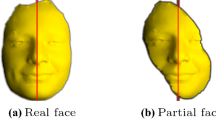Abstract
Symmetry is pervasive in both man-made objects and nature. Since symmetries project to skew symmetries, finding axes of skew symmetry is an important vision task. This paper presents a linear time algorithm for finding the axes of skew symmetry, where the degree of symmetry is known. First, we present a review and critique of current methods for finding the axes of skew symmetry. Next, we decompose the problem of finding skew symmetry into the subproblems of solving for the rotational parameter of a “shear symmetry” and recovering the shear parameter of a reflexive symmetry. Using this approach, the authors derive a direct, non-heuristic moment-based technique for finding the axes of skew symmetry. For skew symmetric figures with degree of symmetry less than five we obtain a closed-form solution. The method does not rely on continuous contours but assumes there is no occlusion and requires knowing the contour's degree of symmetry. It is the first algorithm to find the axes of skew symmetry inO(n) time, where n is the number of contour points. The method is especially suited to industrial applications where the degree of symmetry is often knowna priori. Examples of the method are presented for both real and synthetic images, and an error analysis of the method is given.
Similar content being viewed by others
References
Brady, J.M., and Yuille, A., An extremum principle for shape from contour, MIT, AI Lab., MIT-AIM 711, 1983.
Brady J.M., and Asada H., Smoothed local symmetries and their implementation,International Journal of Robotics Research 3, No. 3, pages 36–61, 1984.
Buchberger, B., Applications of Grobner bases in non-linear computational geometry. In R. Janssen, editor,Trends in computer algebra: international symposium, pages 52–80. Springer-Verlag, 1987.
Friedberg, S.A., Finding Axes of Skewed Symmetry, inComputer Vision, Graphics, and Image Processing,34, pages 138–155, 1986.
Gross, A.D., and Boult, T.E.,Analyzing Skewed Symmetries, Technical Report CUCS-064-90, Department of Computer Science, Columbia University, 1990.
Gross A.D., Boult, T.E., SYMAN: a SYMmetry ANalyzer, in theProceedings of the 1991 Conference on Computer Vision and Pattern Recognition, Lahaina, Hawaii, pages 744–746, June 3–6, 1991.
Gross A.D.,Shape constraints from parametric and non-parametric models, PhD thesis, School of Engineering and Applied Science, Columbia University, May, 1992.
Gross A.D., Towards object-based heuristics, in theProceedings of the 1992 Conference on Computer Vision and Pattern Recognition, pages 818-821, Champaign, Illinois and to appear inIEEE Transactions on Pattern Analysis and Machine Intelligence, August 1994.
Horaud, R., and Brady, J.M., On the geometric interpretation of image contours, inProc. First Int'l Conference on Computer Vision, London, U.K., June 1987.
Kanade, T., Recovery of the 3D shape of an object from a single view,Artificial Intelligence,17, pages 409–460, 1981.
Mohan, R., Perceptual organization for computer vision, PhD thesis, School of Engineering, University of Southern California, August, 1989.
Oh, W. G., Asada, M., and Tsuji, S., Finding of partially occluded skewed symmetry, inProceedings of the 5th Scandinavian Conf. on Image Analysis, pages 191–200, June 1987.
Ponce, J., Ribbons, symmetries, and skewed symmetries, inProceedings of the Image Understanding Workshop, 1988, pages 1074–1079, Massachusetts, 1988.
Reisfeld, D., Wolfson, H., Yeshurun, Y., Detection of interest points using symmetry, inProceedings of the Third International Conference on Computer Vision, Osaka, Japan, pages 62–65, Dec. 1990.
Rosenfeld, A., Axial representation of shape,Computer Vision, Graphics, and Image Processing,33, pages 156–173, 1986.
Saint-Marc, P., and Medioni, G.,B-spline contour representation and symmetry detection, Technical Report, Institute for Robotics and Intelligent Systems, University of Southern California, Los Angeles, CA, Feb 20, 1990.
Stevens, K.A., The visual interpretation of surface contours,Artificial Intelligence 17, pages 47–73, 1981.
Ulupinar, F., and Nevatia, R., Using symmetries for analysis of shape from contour, inProceedings of the Second International Computer Vision Conference, pages 414–426, Dec. 5–8, 1988.
Weyl, H.,Symmetry, Princeton University Press, Princeton, 1952.
Yuen, S.Y.K.,Shape from contour using symmetries, Technical Report, School of Cognitive Sciences, University of Sussex, Falmer, Brighton, BN1 9QN, 1989.
Zabrodsky, H., Peleg, S., and Avnir, D., A measure of symmetry based on shape similarity, In theProceedings of the 1992 Conference on Computer Vision and Pattern Recognition, Champaign, Illinois, pages 703–706, June 15–18, 1992.
Zabrodsky, H., Peleg, S., and Avnir, D., Completion of occluded shapes using symmetry, In theProceedings of the 1993 Conference on Computer Vision and Pattern Recognition, NYC, NY, pages 678–679, June 15–17, 1993.
Author information
Authors and Affiliations
Rights and permissions
About this article
Cite this article
Gross, A.D., Boult, T.E. Analyzing skewed symmetries. Int J Comput Vision 13, 91–111 (1994). https://doi.org/10.1007/BF01420797
Issue Date:
DOI: https://doi.org/10.1007/BF01420797




